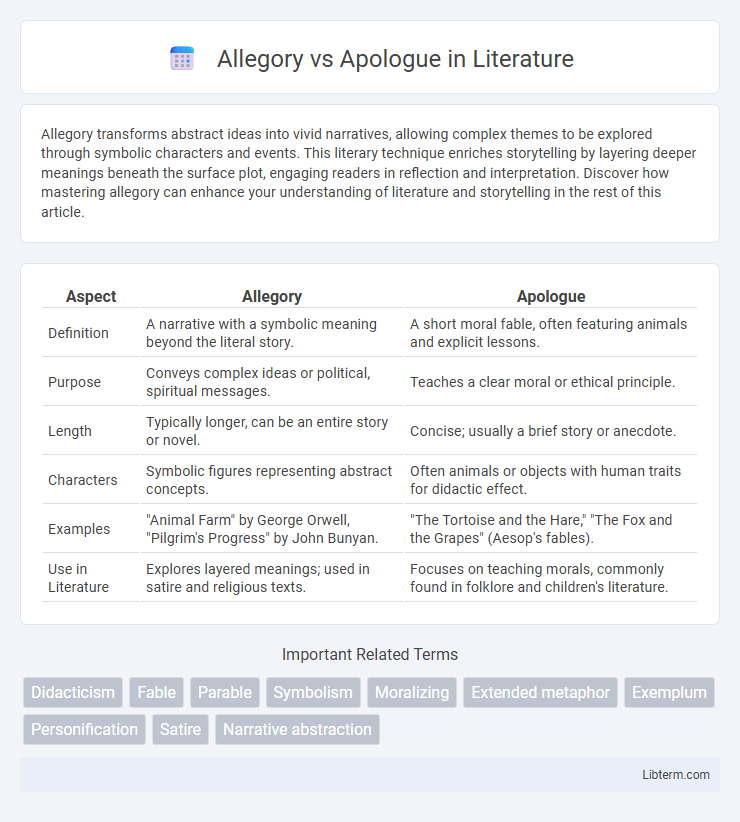Allegory transforms abstract ideas into vivid narratives, allowing complex themes to be explored through symbolic characters and events. This literary technique enriches storytelling by layering deeper meanings beneath the surface plot, engaging readers in reflection and interpretation. Discover how mastering allegory can enhance your understanding of literature and storytelling in the rest of this article.
Table of Comparison
| Aspect | Allegory | Apologue |
|---|---|---|
| Definition | A narrative with a symbolic meaning beyond the literal story. | A short moral fable, often featuring animals and explicit lessons. |
| Purpose | Conveys complex ideas or political, spiritual messages. | Teaches a clear moral or ethical principle. |
| Length | Typically longer, can be an entire story or novel. | Concise; usually a brief story or anecdote. |
| Characters | Symbolic figures representing abstract concepts. | Often animals or objects with human traits for didactic effect. |
| Examples | "Animal Farm" by George Orwell, "Pilgrim's Progress" by John Bunyan. | "The Tortoise and the Hare," "The Fox and the Grapes" (Aesop's fables). |
| Use in Literature | Explores layered meanings; used in satire and religious texts. | Focuses on teaching morals, commonly found in folklore and children's literature. |
Understanding Allegory: Definition and Origins
Allegory is a narrative technique in which characters, events, and settings symbolically represent abstract ideas or moral qualities, allowing for a deeper interpretation beyond the literal meaning. Originating from ancient Greek literature, allegory has been employed across diverse cultures and historical periods to convey complex philosophical, religious, or political messages through metaphorical storytelling. This literary device enhances comprehension by embedding multi-layered meanings within seemingly straightforward narratives, distinguishing it from the more concise and didactic form of apologue.
What is an Apologue? Key Features Explained
An apologue is a brief, didactic narrative that conveys a moral lesson using animals, plants, or inanimate objects as characters, often embodying human traits. Key features of an apologue include its clear ethical message, simplicity in storytelling, and use of allegorical figures to illustrate practical wisdom or societal norms. Unlike longer allegories, apologues are concise, targeting immediate understanding and reflection through vivid, relatable scenarios.
Core Differences: Allegory vs Apologue
Allegory and apologue both use storytelling to impart moral or philosophical lessons, but allegory presents a multi-layered narrative where characters and events symbolically represent broader concepts, often extending across an entire work. In contrast, an apologue is a concise, straightforward tale, typically involving animals or inanimate objects as characters, designed explicitly to deliver a single, clear moral lesson. The core difference lies in allegory's complex, extended symbolism versus apologue's brevity and direct moral focus.
Historical Contexts and Literary Roots
Allegory and apologue both originate from ancient literary traditions, with allegory tracing back to classical Greek and Roman texts where extended metaphorical narratives conveyed complex philosophical and moral ideas. Apologues emerged prominently in fables attributed to Aesop and later adaptations, using brief, instructive stories typically involving animals to illustrate ethical lessons. Historically, allegories often served political or religious purposes in medieval and Renaissance literature, while apologues played crucial roles in folk wisdom and didactic storytelling.
Narrative Structure: How Allegories and Apologues Unfold
Allegories unfold through extended narratives where characters, events, and settings symbolize broader moral, political, or social concepts, creating multiple layers of meaning. Apologues present concise, straightforward stories, often featuring animals or inanimate objects, that deliver a clear, singular moral lesson or practical advice. The complex symbolic framework in allegories contrasts with the direct and didactic structure typical of apologues.
Symbolism in Allegory Compared to Apologue
Allegory employs complex symbolism to represent abstract concepts and moral qualities through extended narratives or images, allowing multiple layers of interpretation across characters, settings, and events. In contrast, an apologue uses straightforward symbolism in brief stories or fables to convey a clear moral lesson, often featuring anthropomorphized animals or objects. The rich symbolic framework in allegory enables a broader philosophical or ideological exploration, while apologue's symbolism primarily focuses on practical ethical guidance.
Purpose and Moral Messaging
Allegories serve to convey complex ideas and moral lessons through extended symbolic storytelling, allowing for multiple layers of interpretation and a broader thematic exploration. Apologues are concise fables or parables designed primarily to impart a clear, straightforward moral or practical lesson, often using animals or inanimate objects as characters. Both forms aim to teach ethical principles, but allegories engage readers with deeper, sometimes abstract messages, while apologues deliver direct and unambiguous moral guidance.
Famous Examples of Allegories and Apologues
Allegories like George Orwell's "Animal Farm" and John Bunyan's "The Pilgrim's Progress" vividly illustrate complex social and moral issues through symbolic storytelling. Famous apologues such as Aesop's fables, including "The Tortoise and the Hare" and "The Fox and the Grapes," use anthropomorphic animals to convey clear ethical lessons. Both literary forms employ narrative symbolism, yet allegories typically explore broader philosophical or political concepts, whereas apologues emphasize practical morals through concise, impactful tales.
Impact on Readers: Interpretation and Engagement
Allegories use extended metaphors that invite readers to decode layered meanings, enhancing engagement through interpretive complexity and fostering deep reflection on abstract ideas. Apologues deliver moral lessons through succinct, illustrative narratives, making the message more accessible and facilitating immediate emotional connection and understanding. Both forms influence interpretation by balancing complexity and clarity, shaping reader engagement through either immersive contemplation or straightforward moral impact.
Choosing Between Allegory and Apologue in Modern Writing
Choosing between allegory and apologue in modern writing depends on the intended level of abstraction and audience engagement. Allegories use extended symbolic narratives to convey complex moral or political meanings, ideal for layered storytelling and philosophical exploration. Apologues present concise, didactic fables featuring anthropomorphized characters, making them effective for clear moral lessons and direct impact in contemporary literature.
Allegory Infographic

 libterm.com
libterm.com